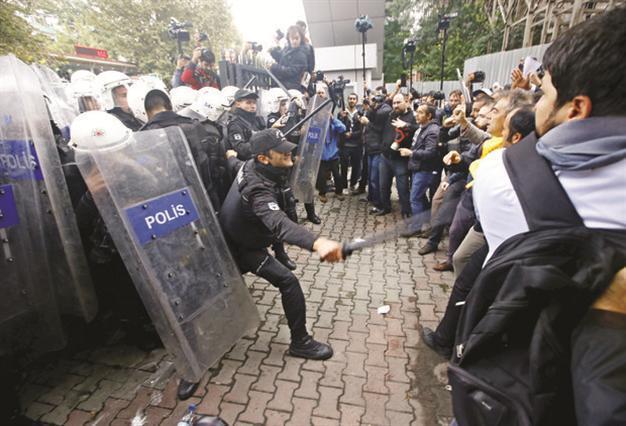Police intervene into protest against Ankara bombing in Istanbul
ISTANBUL – Doğan News Agency

REUTERS photo
Police used force to prevent an attempted march protesting the Oct. 10 Ankara Massacre in Istanbul on Oct. 13 after the Istanbul Governor’s Office denied permission for the rally on the basis of “sensitivity.”
Following a call from the Confederation of Public Sector Trades’ Unions (KESK), the Confederation of Progressive Trade Unions of Turkey (DİSK), the Turkish Medical Association (TTB) and the Union of Chambers of Turkish Engineers and Architects (TMMOB), a march was to be held on Oct. 13, starting at Cerrahpaşa and Sirkeci, two different venues in Istanbul’s Fatih district, before joining in Beyazıt Square, to protest the Ankara bombing and commemorate the 97 victims of the massacre.
But the governor’s office said at around 2 a.m. on Oct. 13 that the application filed for the demonstration had been rejected because “the places where the march was slated to be organized were places citizens use frequently,” because the route for the demonstration “was not among the places listed in the law on meetings and demonstrations” and because of “the sensibility of the current period.”
Police attacked to prevent people from reaching the planned demonstration routes.
Police forces initially refused to permit people to board the Kadıköy-Eminönü ferry, which connects the Asian continent of the city to the European side, in the morning hours of Oct. 13, on the grounds that the march was illegal.
Plainclothes policemen were filmed violently pushing ferry users to the ground in an attempt to detain them.
Mücella Yapıcı, the co-chair of the Chamber of Architects’ Environmental Impact Assessment Board and a member of the Taksim Solidarity Platform, reacted to the police’s attack.
“What are you doing? Our siblings have died,” she yelled at the police, in reference to the 97 victims of the massacre.
A group of people, who intended to march from the Cerrahpaşa Medical Faculty and Hospital to the Beyazıt Square were also prevented by police forces holding shields.
Police did not permit around 1,500 people to exit the hospital’s yard, where the group started a sit-in. The police announced via loudspeakers that the group should hold a press statement in the hospital’s yard and then disperse. As the daily went to press, the group was continuing their sit-in protest.
A group of about 500 people also conducted a sit-in protest in Sirkeci in the shadow of a water cannon, around 30 plainclothes police officers and a squad of riot police. There was brief pushing and shoving between mourners and plainclothes police when the latter attempted to stop protesters from enacting security measures to prevent a similar suicide attack on the gathering. Police were forced to back off, as members of DİSK and Halkevleri (People’s Houses) checked bags of passersby for weapons.
Meanwhile, protests were held against the massacre across the country in multiple cities, varying from İzmir and Uşak in Turkey’s west to Malatya and Adana in the east and south and Giresun and Zonguldak in the north.
Among the cities in the south of the country where protests were held, police also used teargas to attack a group of around 30 lawyers and another 150 people who came to support them in front of the courthouse in the Alanya district of Antalya.
